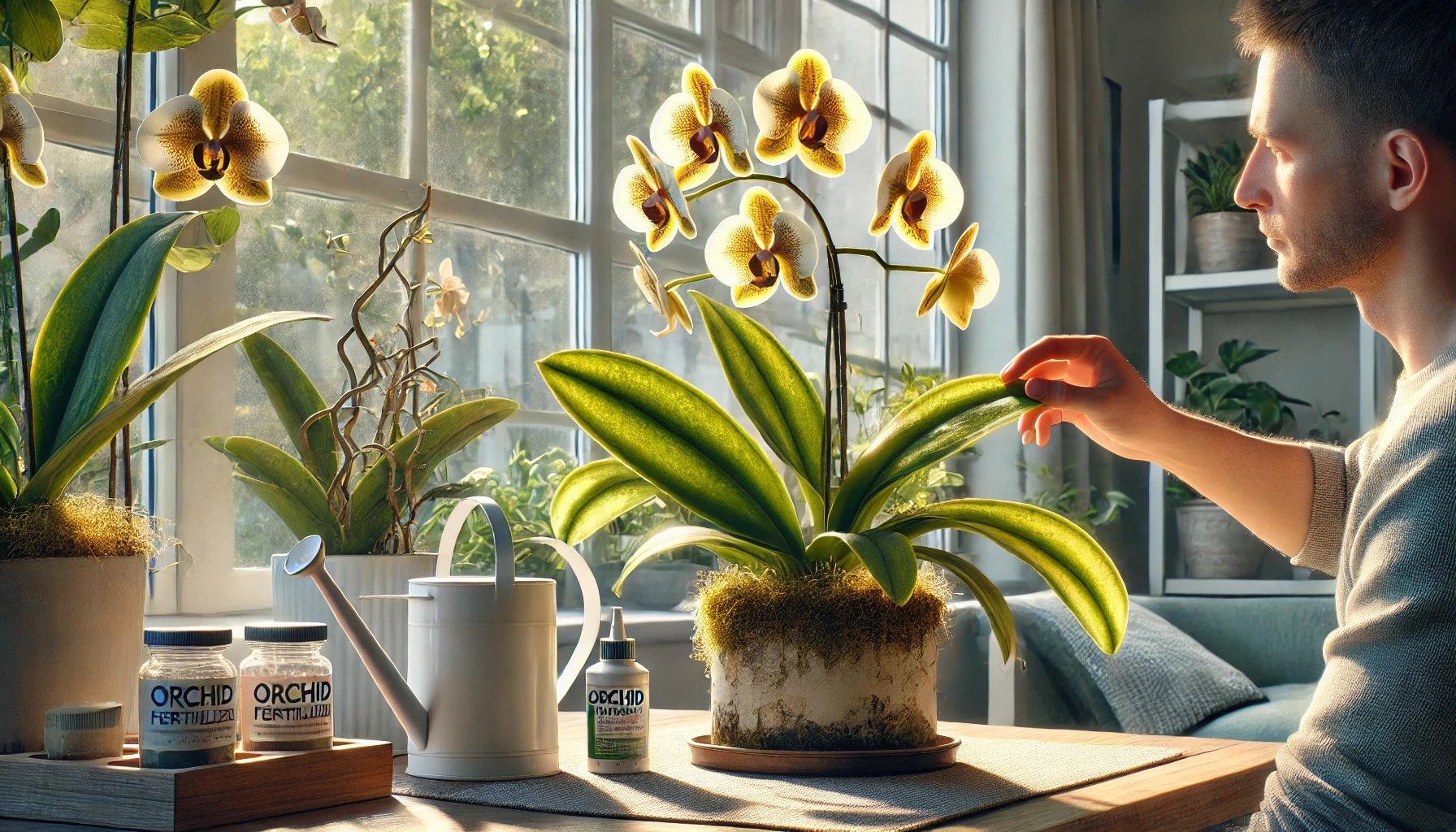Seeing yellow leaves on your orchid can be concerning, especially if you’re unsure what’s causing the problem. While some leaf yellowing is natural, it can also indicate watering issues, nutrient deficiencies, or even disease. Knowing the difference between normal aging and a problem that needs fixing is essential for keeping your orchid healthy.
In this guide, we’ll explore the main reasons why orchid leaves turn yellow and what you can do to fix it.
1. Natural Aging of Leaves
Not all yellowing leaves are a sign of trouble! Orchids naturally shed their older leaves as they grow. If you notice that only the bottom leaves are turning yellow and falling off while the rest of the plant looks healthy, this is a normal process.
What to do:
- Simply let the leaf fall off on its own. Avoid pulling or cutting it too early, as this could damage the plant.
- Keep monitoring new growth. If the top leaves are green and firm, your orchid is healthy.
2. Overwatering (The Most Common Cause)
Overwatering is the number one reason for yellowing leaves in orchids. Unlike regular plants, orchids have aerial roots that need airflow, and too much moisture can lead to root rot.
Signs of overwatering:
- Leaves turn yellow and feel soft or mushy
- Roots appear brown or black instead of green or white
- The potting mix stays wet for too long
How to fix it:
- Check the roots—if they’re mushy, trim off any rotting parts with sterilized scissors.
- Repot the orchid in fresh, well-draining bark mix.
- Let the plant dry out before watering again.
- Adjust your watering schedule: once a week in cooler months, twice a week in warmer months.
3. Underwatering and Dehydration
While overwatering is more common, underwatering can also cause yellow leaves. Orchids need consistent moisture, and if they go too long without water, they lose nutrients, leading to dry, wrinkled leaves.
Signs of underwatering:
- Leaves turn yellow with a wrinkled texture
- Roots appear dry, brittle, or grayish
- The potting mix is extremely dry
How to fix it:
- Soak the orchid’s pot in room-temperature water for 10–15 minutes to rehydrate the roots.
- Adjust watering frequency based on humidity and temperature.
- Ensure the pot has proper drainage so the water doesn’t evaporate too quickly.
4. Too Much Direct Sunlight (Leaf Burn)
Orchids thrive in bright, indirect light, but too much direct sunlight can scorch their leaves. This happens when orchids are placed in south or west-facing windows without any protection.
Signs of sunburn:
- Yellow or brown patches appear on leaves
- The leaf edges become crispy or scorched
- The plant is placed in direct sunlight for long hours
How to fix it:
- Move your orchid to an east-facing window for gentle morning sunlight.
- Use a sheer curtain to filter intense light.
- If necessary, rotate the plant occasionally to prevent uneven exposure.
5. Nutrient Deficiencies
Orchids need regular feeding to stay healthy, and a lack of essential nutrients like nitrogen, potassium, and iron can cause yellowing. If your orchid hasn’t been fertilized in a while, this might be the issue.
Signs of nutrient deficiency:
- The leaves gradually turn yellow (not suddenly).
- Growth slows down or new leaves appear smaller and weaker.
How to fix it:
- Use a balanced orchid fertilizer (20-20-20) diluted to half-strength once a week.
- Fertilize less frequently during winter when the plant is dormant.
- Flush the pot with plain water once a month to remove salt buildup from fertilizer.
6. Temperature Stress
Orchids prefer consistent temperatures between 65–75°F (18–24°C). Exposure to sudden cold drafts or extreme heat can cause stress, leading to yellowing leaves.
Signs of temperature stress:
- Leaves turn yellow after a sudden weather change
- Plant was recently moved near air conditioners, heaters, or cold drafts
- The edges of leaves may turn brown due to extreme dryness
How to fix it:
- Keep your orchid away from air vents, radiators, and cold drafts.
- If the temperature drops at night, use a humidity tray to maintain warmth.
- Avoid placing orchids near hot kitchen appliances that can cause rapid temperature shifts.
7. Pests and Fungal Infections
Though less common, pests like aphids, spider mites, and mealybugs can weaken orchids by sucking out nutrients, leading to yellow or spotted leaves. Fungal infections can also cause discoloration if there is poor air circulation.
Signs of pest infestation:
- Tiny insects visible on leaves or roots
- Sticky residue (honeydew) on leaves
- Yellowing with tiny brown or black spots
How to fix it:
- Wipe the leaves with a mild soap and water solution.
- Use neem oil or insecticidal soap for pest control.
- Improve airflow by placing a fan nearby to prevent fungus growth.
Final Tips for Preventing Yellow Leaves
- Water correctly: Avoid overwatering, but don’t let the roots dry out completely.
- Provide proper lighting: Bright, indirect light is best—filter direct sunlight when needed.
- Feed regularly: Use a diluted orchid fertilizer to prevent nutrient deficiencies.
- Check for pests: Inspect leaves and roots occasionally to catch infestations early.
- Maintain temperature stability: Keep your orchid in a warm, draft-free location.
By understanding the cause of yellow leaves and taking the right action, you can keep your orchid healthy, vibrant, and blooming beautifully for years to come! 🌿🌸
